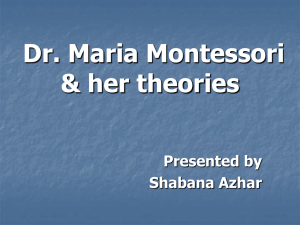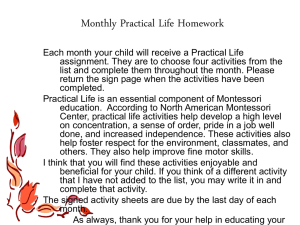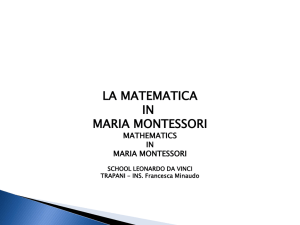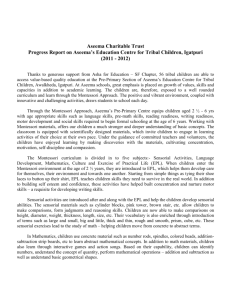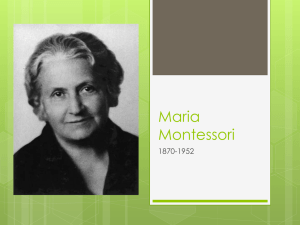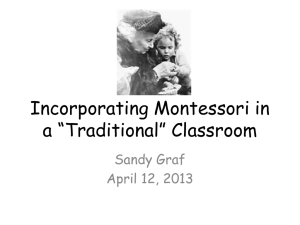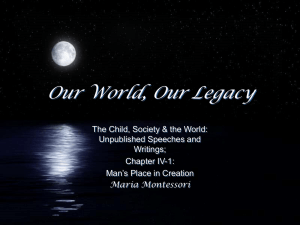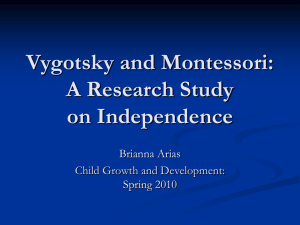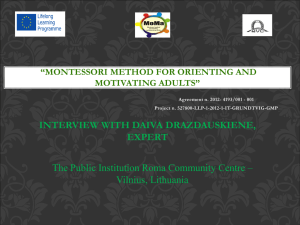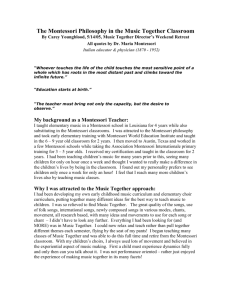Montessori 101 Presentation
advertisement
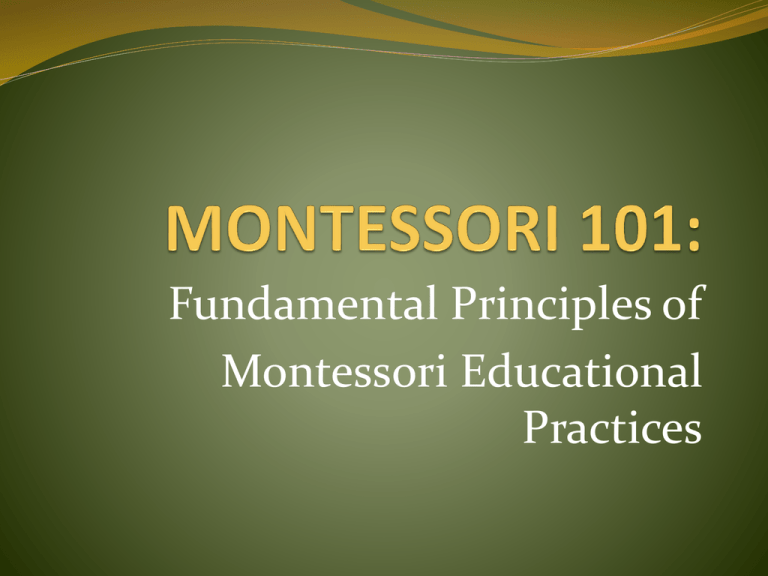
Fundamental Principles of Montessori Educational Practices Medical doctor, scientist & researcher: Thorough understanding of physiological & psychological aspects of the human being Child Psychiatrist: Thorough understanding of brain functions, psychic/mental & emotional development during childhood. Established field of Child Neuro-psychiatry Anthropologist: Thorough understanding the evolution of man as a species Writer, pacifist & international lecturer: Activist & advocate for the rights of women & children “The most important period of life is not the age of university studies, but the first one, the period from birth to the age of six. …the time when man’s intelligence itself, his greatest implement is being formed. But not only his intelligence; the full totality of his psychic powers… At no other age has the child greater need of an intelligent help, and any obstacle that impedes his creative work will lessen the chance he has of achieving perfection.” Montessori: The Absorbent Mind Yesterday: 20th Century Problems: Two world wars and the - - - release of an atomic bomb Question: How to prevent the destruction of the world by war Montessori’s approach: The child is the carrier of knowledge & culture to future generations Understanding the formation of the human personality is essential for positive change Providing an environment to assist & enrich the developing human is critical Today: 21st Century Problem: Depletion of world resources, devastation of the environment, world political & financial upheaval Question: How to prevent the devastation of the world by our lifestyle Montessori educational approach: - Understanding & fostering the development physical, mental, emotional & social structures in children - Providing a suitable environment to assist & support the developmental needs of children - Emphasis on independent functioning understanding freedom & responsibility, ability to communicate ideas respectfully, creativity and resourcefulness Developmental Education: Understand human development & the developmental needs of children Prepared Environment: Design & prepare an environment especially suited to each stage of development to support & enhance development Biology & Environment: Understand the interaction between the inner powers of the biological structure and the environment and how they affect each other Manipulation & Purposeful Activity: Children use their senses and experiences within the environment to achieve physical coordination & to develop intelligence structures Education for Life Education is not limited to academic learning but takes the totality of human life into consideration Inner Discipline Encourages understanding freedom of action and its limits within the social group to gain internal control and conscientious participation within a community “Adaptation is the correlation between life & the environment ” M. Montessori Adaptation: In human species means becoming a person of your place & time: - Children are born with 100 billion neurons and incredible potential. - The highest levels of adaptation occurs during period of childhood. - Children brings the human model with enormous possibilities of adaptation . - Humans have the capacity to adapt to a variety of environmental conditions. For example: arctic, tropic & dessert conditions among others. - Human genetic characteristics are in a constant process of development & transformation through interaction with the environment. The child bring an internal life force from conception which evolves within the context of a prepared environment: - Internal powers of the child: The Human Tendencies, the Absorbent Mind, the Sensitive Periods - External stimulus for development: The Environment/The Prepared Environment The Human Tendencies: Natural tendencies in human species to facilitate adaptation within the environment. They are described as “natural inclinations”, as an “impelling force that will operate if not counteracted”. Human tendencies begin operating at the moment of birth guiding the process of development: - Within the stages of growth - Throughout the evolutionary process of the human species Human Tendencies: - Exploration - Orientation - Adaptation - Communication - Work - Social Behavior - Mathematical Mind - Spiritual Needs Stages/Planes of Development: Montessori refers to them as Planes of Development. Remarkable process lasting around 24 years to maturity or adulthood. Each phase or plane is marked by external and internal changes: - Physical - Mental - Emotional -Social Each plane has specific developmental needs to come to fruition. Each plane is constructed over the strengths or weaknesses of the previous ones. The environment must provide the right enrichment and proper conditions for optimum potential to develop. Four Distinct Planes: Infancy Childhood o t0 6 6 to 12 Adolescence 12 to 18 The Sensorial Explorer: What? The Cultural Explorer: Why? How? When? The Humanistic & Social Explorer: Who am I? Maturity 18 to 24 The Specialist Explorer: How can I change the world? The Absorbent Mind The Sensitive Periods Period of Infancy: Humanization: Establishes the foundation of all the human characteristics Child needs to achieve a complete adaptation to become a person of its place and time, a member of his social group The child achieves his development by the use of his senses by being active and manipulating its environment Subdivided in two distinct sub-phases: - 0 to 3 Unconscious Mind: The Psychic Embryo - 3 to 6 Conscious/Reasoning Mind From birth to 3: The Psychic Embryo The child construct its psyche/mind, the amazing development of the brain’s basic program to: - Develops voluntary movement - Develops language and communication skills - Develops his/her emotional responses - Develops social behavior - Develops basic independent functioning From 3 to 6: Development of the Reasoning Mind The child refines, organizes and classifies all the previous sensorial experiences under the influence of a reasoning mind. The Absorbent Mind: The Absorbent Mind is a special kind of mind, present only during infancy, disappearing around the 6th year of age. The child has the capacity to “absorb” without discrimination ALL information & experiences present in the environment. Unconscious Creator: From 0 to 3 child works unconsciously and “incarnates” all information as part of the basic structure of the brain Conscious Worker: From 3 to 6 child works with conscious awareness of his surroundings, allowing him to refine and correct the characteristics incarnated earlier The Sensitive Periods: Special universal windows of opportunity during infancy for the acquisition of particular traits or skills. Transitory in waning. nature, slowly beginning, intensifying and Possibilities MUST be present in the environment for the child to complete the acquisition these skills. Internally they manifest in the child as an IMPULSE. Externally it manifests as a preference to perform specific work with increased repetition and enthusiasm. Examples: Movement, order, assimilation of images, language and social behavior (these are not the only ones) If not taken advantage of will disappear, leaving the child with a critical characteristic absent and in many cases difficult to obtain at a later moment Environments are carefully prepared according to the developmental needs of the specific stages of development. Activities are designed for the use and active participation of the child through manipulation, repetition & creative use. Presentation of materials & modeling enhances the possibility of the child’s interaction with the environment through activities in critical areas for development. Environment includes developmentally appropriate activities & materials for each distinct stage/phase with: - Purpose, beauty, cleanliness & organization - Well thought out processes to facilitate learning Environment dynamics are implemented as a miniature social community with clear and consistent rules and regulations appropriate for each level of development. Development of inner discipline is fostered by offering choices, respecting the material, the environment, and others participants of the community. The teacher is a guide which carefully prepares the environment with knowledge of the specific stages, observation of children and providing a link to the activities or work through individual or group presentations. Areas in the Prepared Environment: Practical Life Care of the Person Care of the Environment Grace & Courtesy Language Spoken language Writing Reading Function of words Reading analysis Cultural Subjects Geography Science Art Appreciation Music Sensorial Visual discrimination Discrimination of form Tactile sense Auditory sense Sense of smell Sense of taste Mathematics Numbers to 10 Decimal system Teens & tens/Linear counting Memory work Passage to abstraction Fractions Montessori: “The child, making use of all that he finds around him shapes himself for the future” Photo: http://mariamontessori.com/mm/wpcontent/uploads/2010/10/DSC_0023.jpg Studying & understanding the natural development of the human being. Recognition of the powers of the child for “auto-education”. Understanding the special mind of infancy. Providing a suitable prepared environment to address child’s sensitivities & needs. Removing obstacles to development. Fostering independent functioning Golden Rule: Observe – Link – Retreat - Observe Maria Montessori: “If no help is given to a child, if his environment is neglected, his psychic life will be in constant danger… We must assist him from his earliest moments…in a delicate respect for the outward manifestations of this development and in providing those means necessary for his formation which he cannot obtain by his efforts alone.” Parent Education Series By: Maria A. Garcia September 2011
